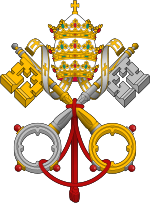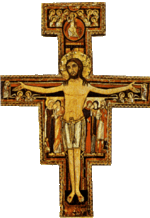Pope Gelasius I
| Saint Gelasius I | |
|---|---|
 |
|
| Papacy began | 492 |
| Papacy ended | November 21, 496 |
| Predecessor | Felix III |
| Successor | Anastasius II |
| Personal details | |
| Birth name | Gelasius |
| Born | Unknown Roman Africa or Rome[1] |
| Died | November 21, 496 Rome, Ostrogothic Kingdom |
| Sainthood | |
| Feast day | November 21 |
| Other Popes named Gelasius | |
| Papal styles of Pope Gelasius I |
|
|---|---|
 |
|
| Reference style | His Holiness |
| Spoken style | Your Holiness |
| Religious style | Holy Father |
| Posthumous style | Saint |
Pope Saint Gelasius I (died November 21, 496) was pope from 492 until his death in 496. He was the third and last pope of African origin in the Roman Catholic Church. Gelasius was a prolific writer whose style placed him on the cusp between Late Antiquity and the Early Middle Ages.[2] Gelasius had been closely employed by his predecessor, Felix III, especially in drafting papal documents. His reign was characterized by his call for strict orthodoxy, a more assertive push for papal authority, and increasing tension between the churches in the West and the East.
Contents |
Struggle with Anastasius I and Acacius
Gelasius' election on March 1, 492 was a gesture for continuity: Gelasius inherited Felix's struggles with Eastern Roman Emperor Anastasius I and the patriarch of Constantinople and exacerbated them by insisting on the removal of the name of the late Acacius, patriarch of Constantinople, from the diptychs, in spite of every ecumenical gesture by the current, otherwise quite orthodox patriarch Euphemius (q.v. for details of the Acacian schism).
The split with the emperor and the patriarch of Constantinople was inevitable, from the western point of view, because they had embraced a view of a single, Divine ('Monophysite') nature of Christ, which was a Christian heresy. Gelasius' book De duabus in Christo naturis ('On the dual nature of Christ') delineated the Western view. Thus Gelasius, for all the conservative Latinity of his writing style stood on the cusp of Late Antiquity and the Early Middle Ages.[2]
Powers of Church and State
During the Acacian schism, Gelasius went further than his predecessors in asserting the primacy of Rome over the entire Church, East and West, and he presented this doctrine in terms that set the model for subsequent popes asserting the claims of papal supremacy.
In 494, Gelasius wrote a very influential letter, known as Duo sunt, to Anastasius on the topic of Church-State relations, whose political impact was felt for almost a millennium. [3].
Suppression of pagan rites and heretics
Closer to home, Gelasius finally suppressed the ancient Roman festival of the Lupercalia after a long contest. Gelasius' letter to Andromachus, the senator, covers the main lines of the controversy and incidentally offers some details of this festival combining fertility and purification that might have been lost otherwise. Significantly, this festival of purification, which had given its name— dies februatus, from februare, "to purify"— to the month of February, was replaced with a Christian festival celebrating the purification of the Virgin Mary instead: Candlemas, observed forty days after Christmas, on February 2.
Gelasius successfully suppressed the Manichaeans, a dualist sect suspected to be present in Rome in large numbers. Gelasius decreed that the Eucharist had to be received "under both kinds", with wine as well as bread. As the Manichaeans held wine to be impure and essentially sinful, they would refuse the chalice and thus be recognized. Later, with the Manichaeans suppressed, the old method of receiving communion under one kind—the bread—was restored.
Death
After a brief but dynamic reign, his death occurred on November 21, 496.
Writings
Gelasius was the most prolific writer of the early popes. A great mass of correspondence of Gelasius has survived: forty-two letters according to the Catholic Encyclopedia, thirty-seven according to Father Bagan[4] and fragments of forty-nine others, carefully archived in the Vatican, ceaselessly expounding to Eastern bishops the primacy of the see of Rome. There are extant besides six treatises that carry the name of Gelasius. According to Cassiodorus, the reputation of Gelasius attracted to his name other works not by him.
Decretum Gelasianum
The most famous of pseudo-Gelasian works is the list de libris recipiendis et non recipiendis ("books to be received and not to be received"), the so-called Decretum Gelasianum, supposed to be connected to the pressures for orthodoxy during the pontificate of Gelasius and intended to be read as a decretal by Gelasius on the canonical and apocryphal books, which internal evidence reveals to be of later date. Thus the fixing of the canon of scripture has traditionally been attributed to Gelasius[5] and a non-historical Roman synod of 494 has been invented as the supposed occasion.
The "Gelasian Sacramentary"
In the Catholic tradition, the so-called "Gelasian Sacramentary", actually the Liber sacramentorum Romanae ecclesiae ("Book of Sacraments of the Church of Rome") is a book of liturgy that was actually composed in Merovingian times. An old tradition linked the book to Pope Gelasius, apparently based on Walafrid Strabo's ascription to him of what is evidently this book. Most of its liturgy reflects the mix of Roman and Gallican practice inherited from the Merovingian church.
Notes
- ↑ Browne, M. (1998). "The Three African Popes.". The Western Journal of Black Studies 22 (1): 57–58. http://www.questia.com/PM.qst?a=o&se=gglsc&d=5001392071. Retrieved 2008-04-10.
- ↑ 2.0 2.1 The title of his biography by Walter Ullmann expresses this:Gelasius I. (492-496): Das Papsttum an der Wende der Spätantike zum Mittelalter (Stuttgart) 1981.
- ↑ Medieval Sourcebook: Gelasius I on Spiritual and Temporal Power
- ↑ Rev. Philip V. Bagan, The Syntax of the Letters of Pope Gelasius I (Catholic University Press) 1945.
- ↑ Tertullian : F.C.Burkitt, Review of The decretum Gelasianum, Journal of Theological Studies 14 (1913) pp. 469–471
References
The main source for the life of Gelasius, aside from Liber Pontificalis, is a vita written by Cassiodorus' pupil Dionysius Exiguus.
- Norman F. Cantor, Civilization of the Middle Ages.
- Catholic Encyclopedia, 1908.
External links
 "Pope St. Gelasius I". Catholic Encyclopedia. 1913.
"Pope St. Gelasius I". Catholic Encyclopedia. 1913.- Duo sunt: introduction and text in English
- Opera Omnia by Migne Patrologia latina with analytical indexes
| Catholic Church titles | ||
|---|---|---|
| Preceded by Felix III |
Pope 492—November 19, 496 |
Succeeded by Anastasius II |
|
|||||||||||||||||||||||||||||||||||||||||||||
|
|||||||||||||||||||||||||||||||||||||||||

